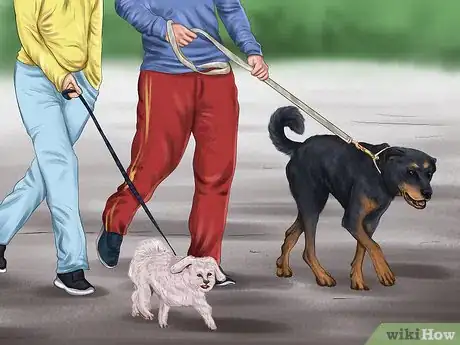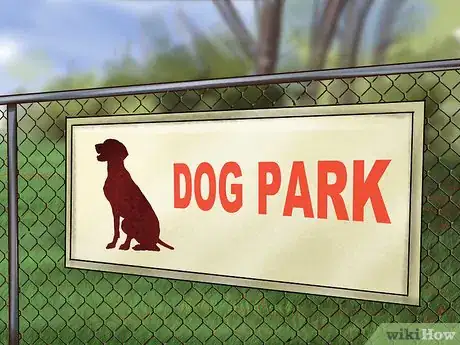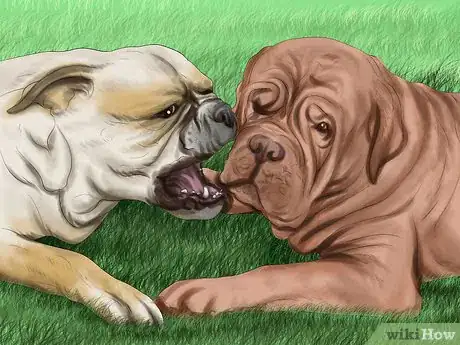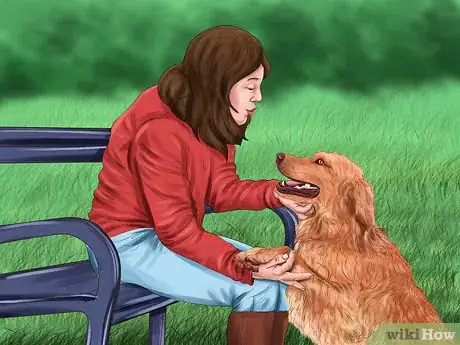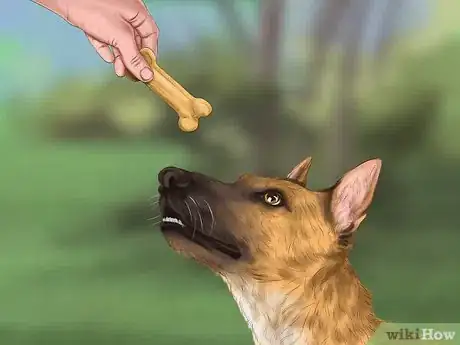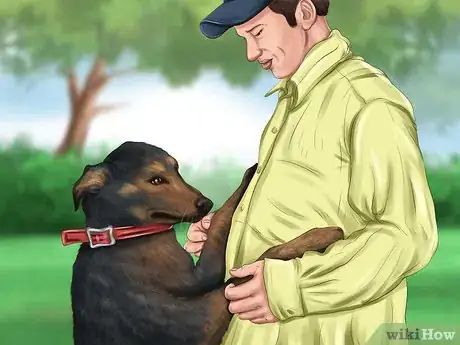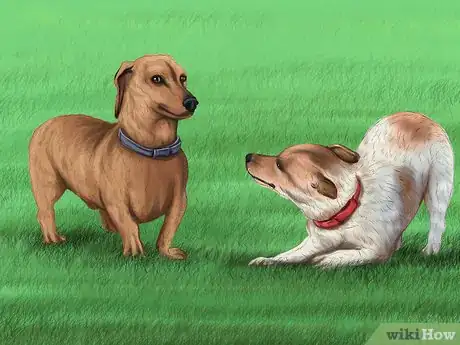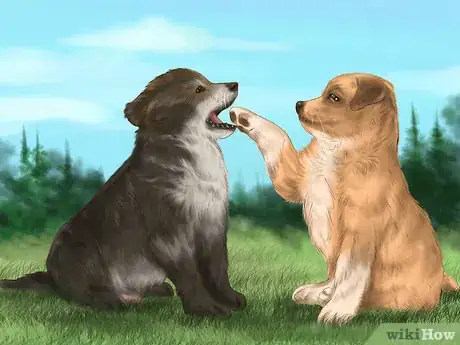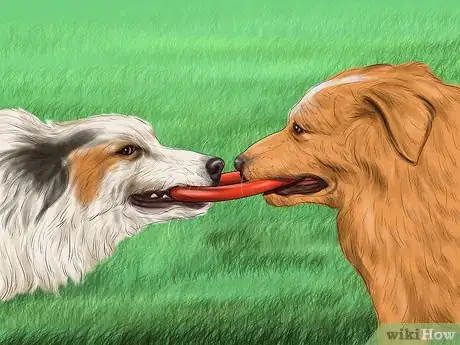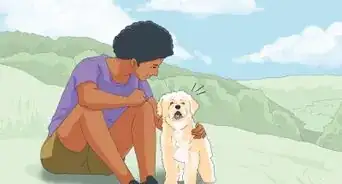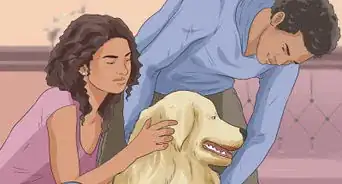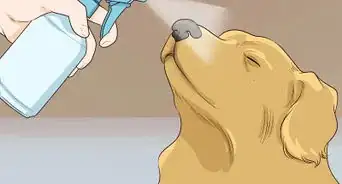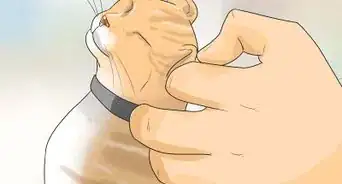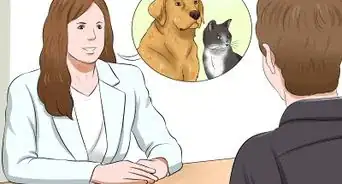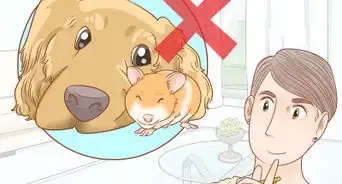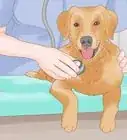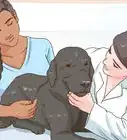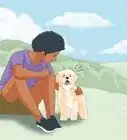This article was co-authored by Jessica Powell. Jessica is a Certified Professional Dog Trainer and the Owner of Proud Paws Dog Training, a small business offering private coaching and in-home dog training services to dog parents across the San Fernando Valley of Los Angeles, California. With nearly ten years of experience, she has extensive knowledge and experience in dog behavior, effective communication techniques, animal welfare, manners training, behavioral modification, and enrichment. Jessica holds a Bachelor of Science degree in Animal Management and is also an experienced shelter professional.
This article has been viewed 49,507 times.
Socializing your dog with other dogs is very important. You want a dog to be able to interact peacefully with a variety of dogs, especially if you're considering bringing a second dog into your home. Socializing an adult dog can be more difficult than socializing a puppy. You will have to start with small interactions with other dogs. Make sure to reinforce positive behavior, and address negative behaviors appropriately. An adult dog may never be fully social or playful with other dogs, but with some dedication you can teach an adult dog to behave in the presence of other animals.
Steps
Exposing Your Dog to Different Dogs
-
1Start with an interaction with a single dog. A socially mature dog, which is a dog between one and three years, will not enjoy playing in a large group of dogs if it is already socialized. Something like a dog park would be overwhelming for your dog. You should start with small, structured interactions with a single dog.[1] Find a friend or family member with a dog that's appropriately socialized and take your dogs on a walk together.[2] [3]
- Find a friend with a gentle, easygoing dog. Have the dogs meet in a neutral location and then walk them together, keeping them at an appropriate distance.
- If the dogs seem calm and well-behaved on their walk, allow them to gently sniff and interact with one another. If any aggressive behavior occurs, talk to both dogs in a soothing voice until they calm down.
- After awhile, the two dogs may get to the point that their bodies and their tails are wagging in one another's presence. At this point, you can let them play together in an off-leash setting like a fenced in yard.
-
2Vary walking routes to meet new dogs. Part of the socialization process is introducing your dog to a variety of new animals and situations. Taking the same walking route each day will limit your dog's experiences. Take a different walking route each day so your dog can see new sights, smells, and dogs.[4]
- Try a lot of different types of environments. A dog should be calm and well-behaved in a variety of places. Try sidewalks, walking paths, dirt roads, and concrete. Vary the amount of activity. Take your dog through a quiet neighborhood one day and a busy part of your city another day.
- If possible, drive to an entirely different neighborhood certain days.
Advertisement -
3Consider a dog park, if it's a safe option. Dog parks can be a great opportunity for a dog to socialize. However, your adult dog may not have been previously socialized. In this case, a dog park may cause it anxiety.[5] If you know your dog has been previously socialized as a puppy, it may benefit from a trip to the dog park. You may not know a lot about your dog's history, especially if you got it at a shelter. If you're unsure whether your dog was previously socialized, keep an eye on its body language at a dog park. Keep your dog on a leash at the park until you get a read of its reactions.[6]
- If your dog stays close to you, avoids other dogs, and growls at any point, a dog park is probably not a safe environment for it. Your dog may not have been previously socialized with other dogs, and may dislike being in large groups of dogs.
- In this case, you should avoid dog parks as a means of socialization. Stick to controlled interactions with individual dogs.
- Think of it like this: if you were super shy, you wouldn't want to placed in a room filled with 35 people, right? The same logic applies to shy dogs.[7]
-
4Remove your dog from situations if it becomes aggressive or nervous. Barking, growling, and other aggressive behaviors are frequently thought of as a way of exerting dominance. Therefore, many people are inclined to punish these behaviors. However, these are actually fear-based behaviors. If your dog becomes aggressive during the socialization process, remove it from the situation and calm it down. This is more effective than punishment.[8]
- Try to distract your dog when it barks at another animal. Call your dog's name or use a treat or a toy as a diversion.
- Remove the dog from the situation. Get it at a safe distance from the other animal. From here, talk to your dog in a soothing voice until it calms down. Once your dog is calm, return it to the situation.
Reinforcing Appropriate Behavior
-
1Praise your dog for remaining calm. Positive reinforcement works better than punishment when you're socializing a dog. When you walk your dog, especially in new environments, praise your dog.[9]
- Remember, an older dog may never be entirely friendly or enthusiastic about other dogs. The goal is to reward calm behavior and not necessarily playful behavior.
- On a walk, each time your dog passes another dog without incident, praise your dog. Offer verbal praise and also give your dog a small pat on the head.
- You do not need to encourage your dog to interact with each dog it meets. This is not necessarily an effective form of socialization. Leash interactions can be stressful for both dogs. Simply work on getting your dog to walk by without incident.
-
2Offer treats as a reward. Treats or food are a great way to reward your dog for positive behavior. In situations where you're likely to bring other dogs, bring a bag of small treats. Each time your dog behaves in the presence of another dog, reward it with a small treat.[10] Offer verbal praise as well.[11]
- Remember to reward right away. Dogs live in the immediate. You need to make sure they understand why they are being rewarded.
-
3Stay calm when your dog gets aggressive or nervous.[12] Socialization of an adult dog can be difficult. It will take awhile for your dog to remain calm in the presence of other animals. In the event your dog gets aggressive or nervous, the worst thing you can do is panic. The dog will interpret your anxiety as a sign it is right to be afraid. Try to remain calm in the face of aggressive behavior.[13]
- A dog needs to assess a situation for itself and determine how to react. If you react before your dog has a chance to, you will affect its behavior.
- Do not change your behavior at all when you near another dog. Avoid tensing up your body, tightening the leash, or talking to the dog in a nervous voice. Keep walking as you were before and let your dog choose how it reacts.
- In the event your dog does become aggressive, remember not to punish it. Simply remove your dog from the situation until it calms down.
-
4Consider professional training. It is not easy to socialize an adult dog. This is especially true if your dog has other behavioral issues. If you're struggling to socialize your dog, professional training may be beneficial.[14]
- You can either join a group class, designed to socialize dogs, or have one-on-one sessions with a dog trainer.
- Make sure you find a trainer that applies positive reinforcement as a training technique.
Avoiding Pitfalls
-
1Do not punish a dog for being scared. Fear-based behaviors will only be reinforced with punishment. Displays of aggression such as growling are almost always due to fear. Punishment will only reinforce your dog's belief it needs to be afraid.[15]
- Instead of punishing your dog, offer an alternative command. For example, immediately say, "Sit" when your dog begins barking or growling at another dog.
- Avoid putting your dog in situations where it may get scared. Do not force a dog to approach a friend or family member's dog if it appears nervous.
-
2Be on the lookout for aggressive or fearful behavior. Socialization can be stressful for adult dogs. As you socialize your dog, be vigilant for aggressive or fearful behavior.[16] Socialization is only successful if it's a pleasant experience for you and your dog. If a dog is scared, you should not push the situation.[17]
- For example, you bring your dog to a friend's house to meet another dog. Your dog stays close to your side, and its body appears tense.
- Your dog is not enjoying itself. You may want to separate the dogs and try again when your dog is more calm. If your dog has negative experiences during the socialization process, this can reverse some progress.
-
3Start young if possible. Ideally, the socialization process should start when your dog is a puppy. Puppies are generally less fearful and tend to respond to new situations with curiosity rather than fear. A puppy may be more easygoing somewhere like a dog park than an adult dog. If you do get your dog when its still a puppy, begin socialization as soon as possible.[18]
-
4Understand an adult dog may never learn to play with other dogs. Many people adopt adult dogs from shelters. These dogs may or may not have been socialized as puppies. If your dog has not been previously socialized, it may never be enthusiastic about playing with other dogs. Keep your expectations realistic. Strive to keep your dog calm and non-aggressive in front of animals rather than overtly friendly and playful.[19]
Expert Q&A
-
QuestionHow do I socialize my aggressive dog with other dogs?
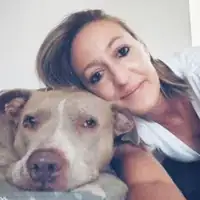 Jessica PowellJessica is a Certified Professional Dog Trainer and the Owner of Proud Paws Dog Training, a small business offering private coaching and in-home dog training services to dog parents across the San Fernando Valley of Los Angeles, California. With nearly ten years of experience, she has extensive knowledge and experience in dog behavior, effective communication techniques, animal welfare, manners training, behavioral modification, and enrichment. Jessica holds a Bachelor of Science degree in Animal Management and is also an experienced shelter professional.
Jessica PowellJessica is a Certified Professional Dog Trainer and the Owner of Proud Paws Dog Training, a small business offering private coaching and in-home dog training services to dog parents across the San Fernando Valley of Los Angeles, California. With nearly ten years of experience, she has extensive knowledge and experience in dog behavior, effective communication techniques, animal welfare, manners training, behavioral modification, and enrichment. Jessica holds a Bachelor of Science degree in Animal Management and is also an experienced shelter professional.
Certified Professional Dog Trainer Ask yourself if there is a reason for you to worry about your dog becoming aggressive in a social environment. If your dog has ever bitten a person or is exhibiting stress-related behaviors, there may be certain social situations that are not safe or enjoyable for them to be in. Always remember and understand that ‘socializing’ does not have to mean direct contact with things. Try to find suitable activities for your pet.
Ask yourself if there is a reason for you to worry about your dog becoming aggressive in a social environment. If your dog has ever bitten a person or is exhibiting stress-related behaviors, there may be certain social situations that are not safe or enjoyable for them to be in. Always remember and understand that ‘socializing’ does not have to mean direct contact with things. Try to find suitable activities for your pet. -
QuestionHow can I help my puppy socialize?
 Jessica PowellJessica is a Certified Professional Dog Trainer and the Owner of Proud Paws Dog Training, a small business offering private coaching and in-home dog training services to dog parents across the San Fernando Valley of Los Angeles, California. With nearly ten years of experience, she has extensive knowledge and experience in dog behavior, effective communication techniques, animal welfare, manners training, behavioral modification, and enrichment. Jessica holds a Bachelor of Science degree in Animal Management and is also an experienced shelter professional.
Jessica PowellJessica is a Certified Professional Dog Trainer and the Owner of Proud Paws Dog Training, a small business offering private coaching and in-home dog training services to dog parents across the San Fernando Valley of Los Angeles, California. With nearly ten years of experience, she has extensive knowledge and experience in dog behavior, effective communication techniques, animal welfare, manners training, behavioral modification, and enrichment. Jessica holds a Bachelor of Science degree in Animal Management and is also an experienced shelter professional.
Certified Professional Dog Trainer When training puppies, simply learning to remain calm around things in the environment (people, other animals, moving objects, novel items) and getting rewarded by their humans during gentle exposure to the world is great socialization and very proactive in preventing aggressive type responses later in life.
When training puppies, simply learning to remain calm around things in the environment (people, other animals, moving objects, novel items) and getting rewarded by their humans during gentle exposure to the world is great socialization and very proactive in preventing aggressive type responses later in life. -
QuestionHow do I socialize my older dog with other dogs?
 Jessica PowellJessica is a Certified Professional Dog Trainer and the Owner of Proud Paws Dog Training, a small business offering private coaching and in-home dog training services to dog parents across the San Fernando Valley of Los Angeles, California. With nearly ten years of experience, she has extensive knowledge and experience in dog behavior, effective communication techniques, animal welfare, manners training, behavioral modification, and enrichment. Jessica holds a Bachelor of Science degree in Animal Management and is also an experienced shelter professional.
Jessica PowellJessica is a Certified Professional Dog Trainer and the Owner of Proud Paws Dog Training, a small business offering private coaching and in-home dog training services to dog parents across the San Fernando Valley of Los Angeles, California. With nearly ten years of experience, she has extensive knowledge and experience in dog behavior, effective communication techniques, animal welfare, manners training, behavioral modification, and enrichment. Jessica holds a Bachelor of Science degree in Animal Management and is also an experienced shelter professional.
Certified Professional Dog Trainer When considering play dates for socialization with older dogs, some good cautionary tips are to pick compatible play-mates, to keep play sessions short to prevent over-stimulation or play becoming too rough and to remove resources such as toys, food bowls and beds that dogs can become potentially possessive over.
When considering play dates for socialization with older dogs, some good cautionary tips are to pick compatible play-mates, to keep play sessions short to prevent over-stimulation or play becoming too rough and to remove resources such as toys, food bowls and beds that dogs can become potentially possessive over.
References
- ↑ https://www.animalhumanesociety.org/behavior/socializing-your-dog
- ↑ Rendy Schuchat. Certified Professional Dog Trainer. Expert Interview. 26 January 2021.
- ↑ Jessica Powell. Certified Professional Dog Trainer. Expert Interview. 5 October 2021.
- ↑ https://www.animalhumanesociety.org/behavior/socializing-your-dog
- ↑ Rendy Schuchat. Certified Professional Dog Trainer. Expert Interview. 26 January 2021.
- ↑ https://www.animalhumanesociety.org/behavior/socializing-your-dog
- ↑ Rendy Schuchat. Certified Professional Dog Trainer. Expert Interview. 26 January 2021.
- ↑ https://www.animalhumanesociety.org/behavior/socializing-your-dog
- ↑ https://www.animalhumanesociety.org/behavior/socializing-your-dog
- ↑ Jessica Powell. Certified Professional Dog Trainer. Expert Interview. 5 October 2021.
- ↑ https://www.animalhumanesociety.org/behavior/socializing-your-dog
- ↑ Jessica Powell. Certified Professional Dog Trainer. Expert Interview. 5 October 2021.
- ↑ https://www.animalhumanesociety.org/behavior/socializing-your-dog
- ↑ Jessica Powell. Certified Professional Dog Trainer. Expert Interview. 5 October 2021.
- ↑ https://www.animalhumanesociety.org/behavior/socializing-your-dog
- ↑ Jessica Powell. Certified Professional Dog Trainer. Expert Interview. 5 October 2021.
- ↑ https://www.animalhumanesociety.org/behavior/socializing-your-dog
- ↑ http://pets.webmd.com/dogs/guide/socializing-new-puppy
- ↑ https://www.animalhumanesociety.org/behavior/socializing-your-dog
About This Article
To socialize your adult dog with other dogs, introduce it to a friend or family member’s dog, since mature dogs get on better with one-on-one interactions rather than large groups. You could also try varying your walking route each day, which will increase the chances of your pet meeting other dogs. When you first introduce it to the other dog, keep your pet on a leash so you can keep control of it. Encourage it to stay calm by offering it a treat and praising its behavior. If both dogs remain calm, let your pet sniff and gently play with the other dog. However, if it appears tense or aggressive, separate the dogs and try again later, since it’s important to make socialization a positive experience for your pet. For tips from our Veterinary co-author, including how to socialize your dog at a dog park, keep reading!



